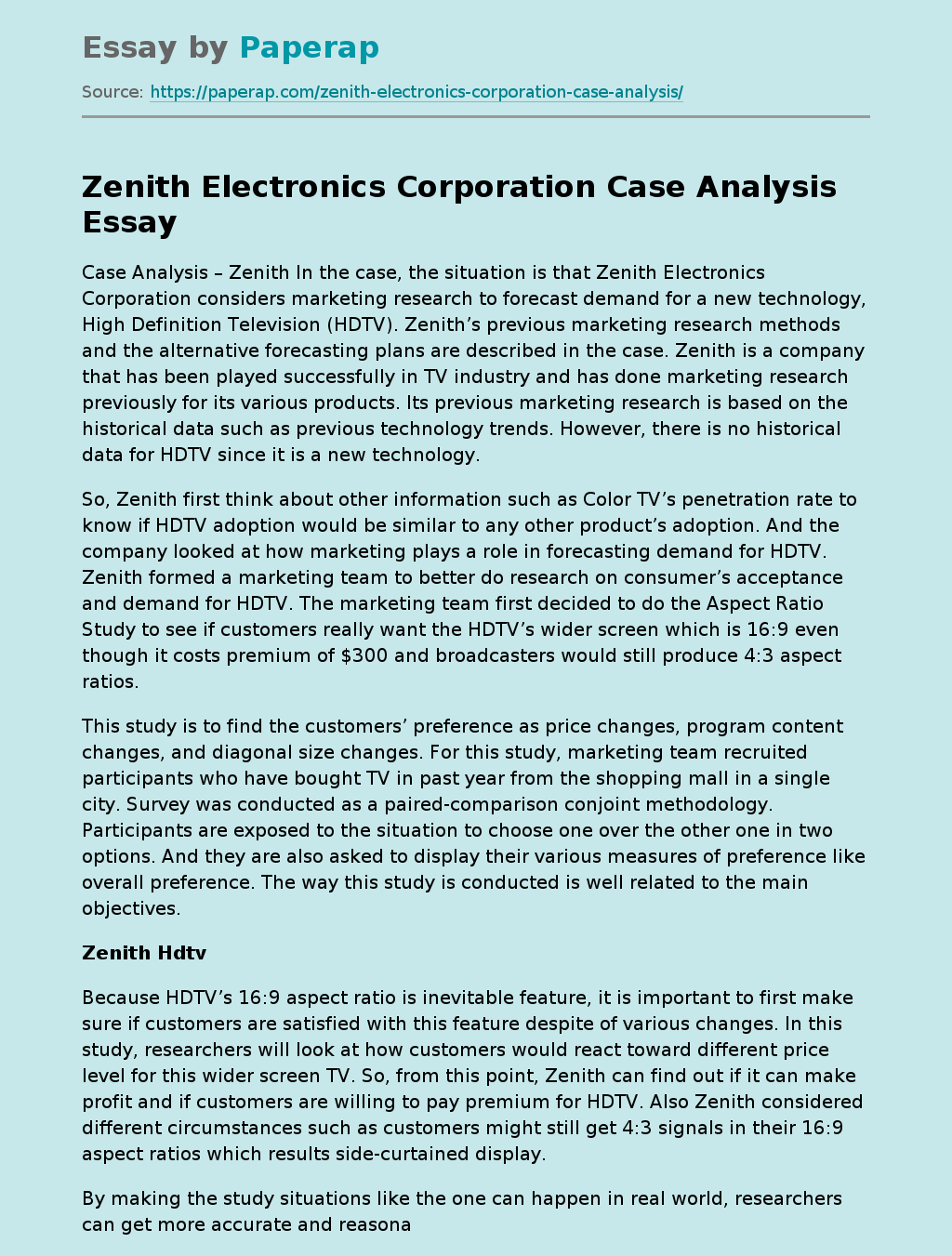Case Study Zenith on New Technology
The following sample essay talks about Zenith’s case study on emerging technologies. To read the introduction, body, and conclusion of the essay, scroll down.
Case Analysis – Zenith In the case, the situation is that Zenith Electronics Corporation considers marketing research to forecast demand for a new technology, High Definition Television (HDTV). Zenith’s previous marketing research methods and the alternative forecasting plans are described in the case. Zenith is a company that has been played successfully in TV industry and has done marketing research previously for its various products.
Its previous marketing research is based on the historical data such as previous technology trends. However, there is no historical data for HDTV since it is a new technology.
So, Zenith first think about other information such as Color TV’s penetration rate to know if HDTV adoption would be similar to any other product’s adoption. And the company looked at how marketing plays a role in forecasting demand for HDTV.
Zenith formed a marketing team to better do research on consumer’s acceptance and demand for HDTV. The marketing team first decided to do the Aspect Ratio Study to see if customers really want the HDTV’s wider screen which is 16:9 even though it costs premium of $300 and broadcasters would still produce 4:3 aspect ratios.
This study is to find the customers’ preference as price changes, program content changes, and diagonal size changes. For this study, marketing team recruited participants who have bought TV in past year from the shopping mall in a single city.
Survey was conducted as a paired-comparison conjoint methodology. Participants are exposed to the situation to choose one over the other one in two options. And they are also asked to display their various measures of preference like overall preference. The way this study is conducted is well related to the main objectives.
Zenith Hdtv
Because HDTV’s 16:9 aspect ratio is inevitable feature, it is important to first make sure if customers are satisfied with this feature despite of various changes. In this study, researchers will look at how customers would react toward different price level for this wider screen TV. So, from this point, Zenith can find out if it can make profit and if customers are willing to pay premium for HDTV. Also Zenith considered different circumstances such as customers might still get 4:3 signals in their 16:9 aspect ratios which results side-curtained display.
By making the study situations like the one can happen in real world, researchers can get more accurate and reasonable data from the study. As looking at this research technique in the other side, there are some possible shortcomings or errors in the Aspect Ratio Study. The place where participants would be recruited is limited. They would be selected from a shopping mall only in a single city. Because the place is limited to a single city, there is possibility the data would be not accurate and would not work for other cities.
As another potential error in this study is that the result data would not be a very detailed or useful to forecast actual demand for HDTV. Because this is just a repeated comparison of two options and making choices, customers might not have enough time to be sure they actually want one option. Overall result may indicate how customers make trade-offs and customer preference. However, in real world, there isn’t always the situation of choosing one thing over another one. There are countless options of values to choose for customers.
Besides this Aspect Ratio Study, five other alternative plans to consider are described in the end of the case. First one to consider is Dealer Research. This technique would be helpful to understand dealer’s concerns and to build up a good relationship with dealers. But my critique is that customers might be skeptical towards dealers even though this research would help controlling the sales channel to influence customers in retail stores. Zenith also considers Secondary Source Research as another option. This research is attractive in a fact that it could be done immediately.
However, because HDTV is a very new technology, it would not be accurate to forecast the growth of HDTV industry by using historical data on all other electronics. For rest of research plans’ biggest shortcoming is the time. HDTV innovators and qualitative research on early adoption could be placed in next year. Also for this research, it only aims for innovators and early adopters. So there is possibility that data would not reach customers after them. And HDTV/NTSC-TV preference test can also be done in next year.
This study actually needs to have a working model of HDTV. So it might be more effective. However, developing the program for the study might cost a lot. As a last alternative, HDTV consumer awareness/”halo effect” survey is the most time-consuming study. This can be done only after HDTV is introduced in the market. So, there is a risk of failure or a possibility of negative impact on company when they actually launched HDTV production. If the introduction isn’t effective enough, it would be very high-cost to do this survey.
Case Study Zenith on New Technology. (2019, Dec 05). Retrieved from https://paperap.com/zenith-electronics-corporation-case-analysis/

